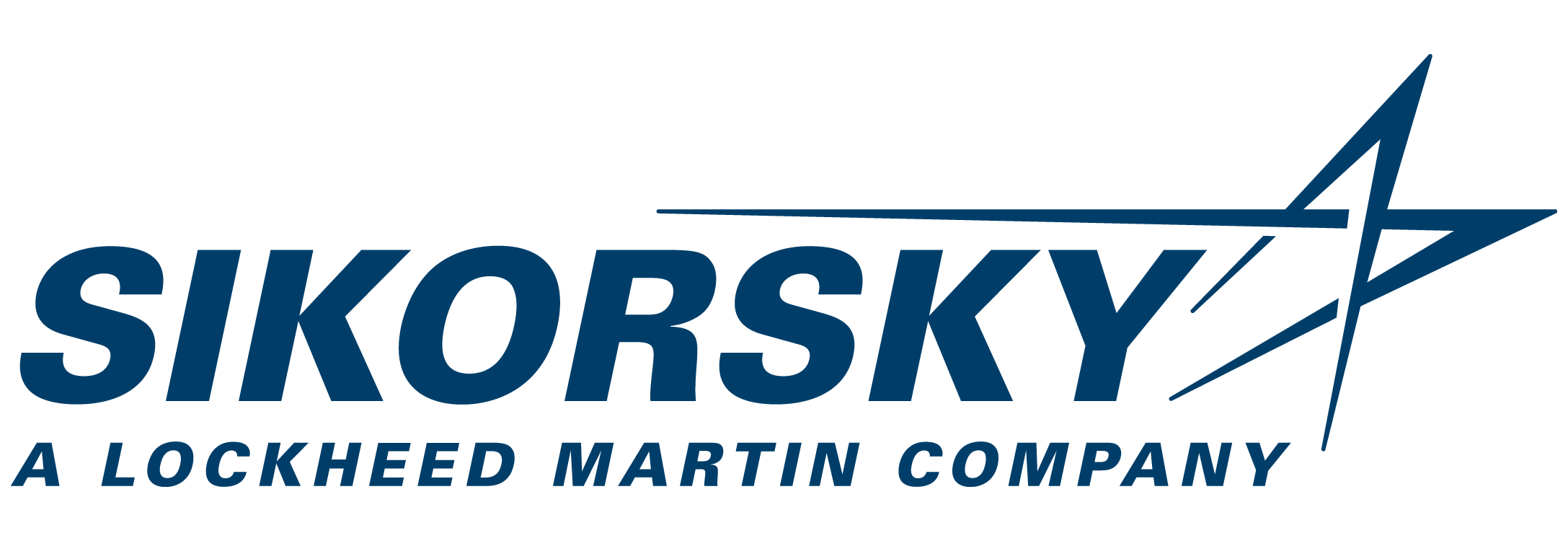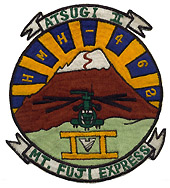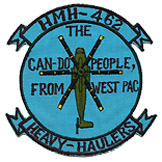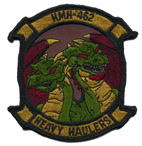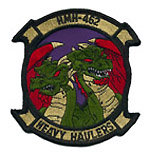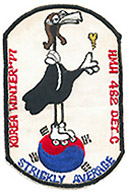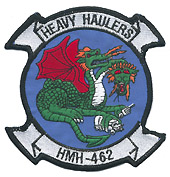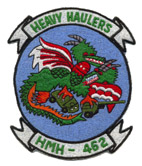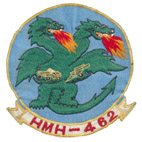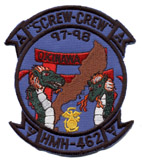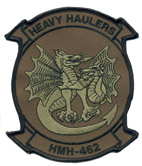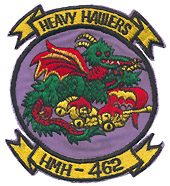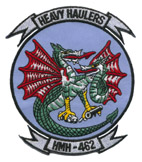
HMH-462 Squadron Patch
History of HMH-462
Marine Heavy Helicopter Squadron 462 traces its lineage back 15 April 1944, when VMF-462 was established in El Centro, California. In October 1944, VMF-462 was assigned to Marines Base Defense Aircraft Group 46 at MCAS El Toro, California. The squadron was deactivated 10 September 1945 and placed in cadre status.
On 1 November 1957, 462 was reactivated at MCAF(H) Santa Ana, California as Marine Helicopter Transport Squadron (Medium) 462 [HMR(M)-462]. In March, 1958 the squadron received the Sikorsky HR2S-1(CH-37C), known as the “Deuce.” The 23,000lbs “Deuce” was capable of transporting 36 Marines or 10,000 lbs of cargo. HMR(M)-462 utilized this aircraft in a variety of roles during the late 1950s to mid 1960s. In July, 1958 the squadron participated in NASA’s abort recovery tests of the Mercury space capsule in the Salton Sea. During July, 1959 HMR(M)-462 worked with the US Army in El Paso, Texas to conduct the initial aerial transport tests of the Hawk missile system. One year later, the squadron worked with Convair Astronautics Corporation in San Diego to help construct Atlas missile silos. Also during 1960, HMR(M)-462 joined with the FAA, Sikorsky Aircraft, the US Army, NY Airways and British technical representatives of the Decca Corporation to establish Instrument Flight Procedures for helicopters.
On November 18, 1963 the squadron was named an honorary member of the Havasupi Indian Tribe. The “Heavy Haulers earned this recognition following their efforts to supply the reservation with necessary supplies in the Arizona desert. During the mid-1960s the squadron changed their logo and began acceptance of the CH-53A “Stallion.”
In August 1968, the “Heavy Haulers” deployed to the Republic of Vietnam for combat operations. Assigned to MAG-36 at Phu Bai, the squadron was tasked with the tactical retrieval of downed aircraft and heavy equipment during operation “END SWEEP.” In October 1969, HMH-462 was transferred to Okinawa to provide support to Marine forces in Japan. In 1975 HMH-462, still stationed in Okinawa, was assigned to the 9th MAB and 31st MEU. In April of that year the “Heavy Haulers” participated in the evacuation of Phnom Penh, during operation “EAGLE PULL.”
After nearly ten years of continuous overseas service, HMH-462 was relocated to MCAS(H) Tustin, California and assigned to Marine Aircraft Group 16. While participating in the Unit Deployment Program to MCAS Futenma, Okinawa, the squadron continually supported numerous overseas exercises conducted in Japan, the Republic of the Philippines and Korea, including “TEAM SPIRIT.” In December 1989, a squadron detachment was assigned to participate in coup contingency operations in the Republic of the Philippines as part of Marine Aircraft Group 90.
In August 1990, the “Heavy Haulers” were assigned to Marine Aircraft Group 70 and deployed to NAF Jubayl, Saudi Arabia as part transport, MEDEVAC, VIP, and FARP support to MAG-70/16 and I MEF operations.
In February 1991, the squadron relocated to Tanajib, Saudi Arabia, where it provided support for Desert Storm combat operations in Kuwait. Following the conclusion of hostilities, the “Heavy Haulers” returned to MCAS(H) Tustin. During March of 1991, the squadron received the 1990 Chief of Naval Operations Safety Award – a significant achievement in view of the extensive high tempo operations completed during Gulf War. HMH-462 maintained its high tempo of operations for the remainder of 1991 despite a high rate of personnel turnover, including two deployments to Indian Springs AFAF, NV and attendance of Weapons and Tactics Instructor Course 1-92, MAWTS-1, MCAS Yuma, AZ. In September, the squadron reached another milestone when it completed 15,000 class A mishap free flight hours.
The start of 1992 found HMH-462 shifting into high gear with several squadron deployments. It was also announced that HMH-462 had been selected for transition to the CH-53E aircraft. In June, the Heavy Haulers took possession of their first CH-53E “Super Stallion” and began the transition process.
In the short time of a year, the “Heavy Haulers” retrained all of the pilots, aircrew, and mechanics. Once operational, HMH-462 participated in Combined Arms Exercise 5/6-93, and Desert Firex ’93, attended Weapons and Tactics Instructor Course 2-93, and made two squadron deployments to MCAS Yuma. The squadron trained and provided fully combat qualified “Super Stallion” support to the 11th MEU, and completed a deployment to Okinawa, Japan while also providing support to the 31st MEU.
In 1996, the squadron reached another milestone when it completed 28,000 class A mishap free flight hours. In May of the same year, after completing another unit deployment to Okinawa, Japan, HMH-462 became the first CH-53E squadron in UDP history to maintain the CNO’s operational readiness goal throughout an entire deployment cycle. Additionally, the “Heavy Haulers” received the Heavy Helicopter Squadron of the Year Award from the Marine Corps Aviation Association for 1996 and supported the SPMAGTF-1, Sea Dragon.
In March 1997, HMH-462 surpassed 30,000 class A mishap free flight hours. After returning home in May 1998 from another unit deployment cycle, the “Heavy Haulers” departed MCAF Tustin, for the last time. They became the first helicopter squadron in MAG-16 to make the transition from Tustin to MCAS Miramar, San Diego, California. In December of the same year, HMH-462 surpassed yet another class A mishap free flight hour milestone of 35,000 hours and received the Heavy Helicopter Squadron of the Year award for 1998.
During 1999,the “Heavy Haulers” have participated in numerous exercises including a Combined Arms Exercise in 29 Palms, California, a Weapons and Tactics Instructor Course at MCAS Yuma, AZ, Exercise Seahorse Wind ’99 at Fort Hunter Liggett, CA, as well as squadron deployments to NAF El Centro, California, Indian Springs AFAF, NV, and Fallon, NV.
From December, 1999 through July, 2000 HMH-462 deployed to Okinawa, Japan. Highlights of the tour included Operation Balikatan 2000; this was the first time U.S. forces returned to the Philippines since departing in 1991. The squadron also conducted numerous detachments to Korea and mainland Japan.
HMH-462 served in Operation IRAQI FREEDOM (OIF) from February 2003 to September 2003 and Operation ENDURING FREEDOM (OEF) from September 2004 to May 2005. They flew many missions supporting logistics and combat missions involving insertion and extraction of special forces groups. In 2008, the squadron deployed in support of OIF and OEF. Following a short dwell time, the squadron deployed to Iraq in July 2009 in support of OIF and was retasked and transitioned to Afghanistan in support of OEF in November 2009. The squadron returned to CONUS at the end of January 2010.
Most recently, HMH-462 served with the 15th MEU in 2010 providing disaster relief in Pakistan and on the 31st MEU in 2011 providing disaster relief to Japan during Operation TOMODACHI. HMH-462 currently has detachments serving in Afghanistan supporting OEF and with the 11th MEU.
